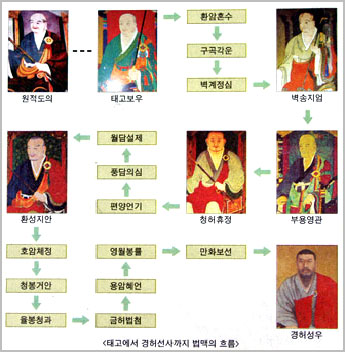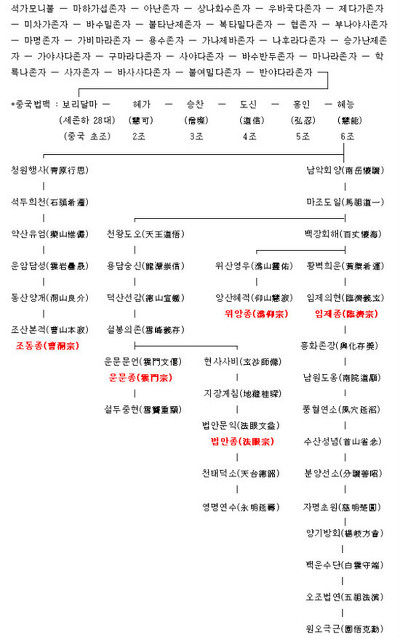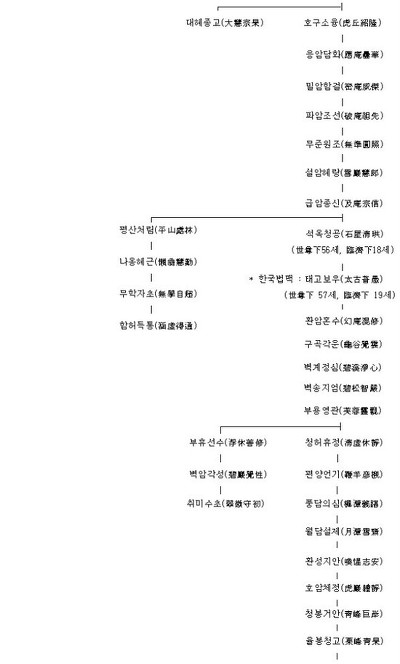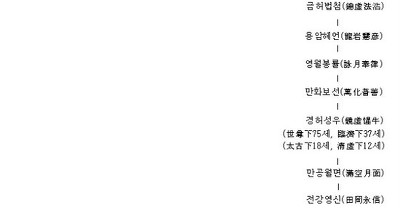ZEN IRODALOM ZEN LITERATURE
≪ Zen főoldal
≪ vissza a Terebess Online nyitólapjára
Korean Lineage Charts of the Zen Ancestors
中國祖師 Chinese Patriarchs
28/1. Bodhidharma; 菩提達磨 Puti Damo (?-532)
보제달마 Boje Dalma
29/2. 大祖慧可 Dazu Huike (487-592)
대조혜가 Daejo Hyega
30/3. 江西僧璨 Jiangxi Sengcan (?-606)
강서승찬 Gangseo Seungchan
31/4. 大義道信 Dayi Daoxin (580-651)
대의도신 Daeui Dosin
32/5. 道門弘忍 Daomen Hongren (602-675)
도문홍인 Domun Hongin
33/6. 大江慧能 Dajiang Huineng (683-713)
대강혜능 Daegang Hyeneung
34/7. 南 跃懷讓 Nanyue Huairang (677-744)
남악회양 Namak Hoeyang
35/8. 馬祖道一 Mazu Daoyi (709-788)
마조도일 Majo Doil
36/9. 百丈懷海 Baichang Huaihai (720-814)
백장회해 Baekjang Hoehae
37/10. 黄蘗希運 Huangbo Xiyun (720-850)
황벽희운 Hwangbyeok Huiun
38/11. 臨濟義玄 Linji Yixuan (?-867)
임제의현 Imje Uihyeon
39/12. 興化存奬 Xinghua Cunjiang (830-888)
흥화존장 Heunghwa Jonjang
40/13. 南院慧顒 Nanyuan Huiyong (860-930)
남원도옹 Namwon Doong
41/14. 風穴延沼 Fengxue Yanzhao (896-973)
풍혈연소 Punghyeol Yeonso
42/15. 首山省念 Shoushan Shengnian (926-993)
수산성념 Susan Seongnyeom
43/16. 汾陽善昭 Fenyang Shanzhao (947-1024)
분양선소 Bunyang Seonso
44/17. 石霜楚圓 Shishuang Chuyuan (987-1040)
자명초원 Jamyeong Chowon
45/18. 楊岐方會 Yangqi Fanghui (993-1046)
양기방회 Yanggi Banghoe
46/19. 白雲守端 Baiyun Shouduan (1025–1072)
백운수단 Baegun Sudan
47/20. 五祖法演 Wuzu Fayan (?-1104)
오조법연 Ojo Beobyeon
48/21. 圓悟克勤 Yuanwu Keqin (1063-1135)
원오극근 Wono Geukgeun
49/22. 虎丘紹隆 Huqiu Shaolong (1077-1136)
호구소융 Hogu Soyung
50/23. 應庵曇華 Yingan Tanhua (1103-1163)
응암담화 Eungam Damhwa
51/24. 密庵咸傑 Mian Xianjie (1118-1186)
밀암함걸 Miram Hamgeol
52/25. 破庵祖先 Poan Zuxian ( 1136-1211)
파암조선 Paam Joseon
53/26. 無準師範 Wuzhun Shifan (1177-1249)
무준원조 Mujun Wonjo
54/27. 雪巖惠朗 Xueyan Huilang (n.d.)
설암혜랑 Seoram Hyerang
55/28. 及庵宗信 Jian Zongxin (n.d.)
급암종신 Geubam Jongsin
56/29. 石屋淸珙 Shiwu Qinggong (1270-1352)
석옥청공 Seogok Cheonggong
韓國祖師 Korean Patriarchs
57/30/1. 태고보우 / 太古普愚 Taego Bou (1301-1382)
58/31/2. 환암혼수 / 幻庵混修 Hwanam Honsu (1320-1392)
59/32/3. 구곡각운 / 龜谷覺雲 Gugok Gakun (n.d.)
60/33/4. 벽계정심 / 碧溪淨心 Byeokgye Jeongsim (?-1492)
61/34/5. 벽송지엄 / 碧松智嚴 Byeoksong Jieom (1464-1534)
62/35/6. 부용영관 / 芙蓉靈觀 Buyong Yeonggwan (1485-1567/71)
63/36/7. 청허휴정 / 淸虛休靜 Cheongheo Hyujeong (1520-1604)
64/37/8. 편양언기 / 鞭羊彦機 Pyeonyang Eon-gi (1581-1644)
65/38/9. 풍담의심 / 楓潭義諶 Pungdam Euisim (1592-1665)
66/39/10. 월담설제 / 月潭雪霽 Woldam Seolje (1632-1704)
67/40/11. 환성지안 / 喚惺志安 Hwanseong Jian (1664-1729)
68/41/12. 호암체정 / 虎巖體淨 Hoam Chejeong (n.d.)
69/42/13. 청봉거안 / 靑峰巨岸 Cheongbong Geoan (1710-1793)
70/43/14. 율봉청고 / 栗峰靑古 Yulbong Cheonggo (n.d.)
71/44/15. 금허 법첨 / 錦虛法沾 Geumheo Beopcheom (n.d.)
72/45/16. 용암혜언 / 龍岩慧彦 Yongam Hyeeon (n.d.)
73/46/17. 영월봉율 / 永月奉律 Yeongwol Bongyul (1738-1823)
74/47/18. 만화보선 / 萬化普善 Manhwa Boseon (n.d.)
75/48/19. 경허성우 / 鏡虛惺牛 Gyeongheo Seongu (1849-1912)
76/49/20. 혜월혜명 / 慧月慧明 Hyewol Hyemyeong (1862-1937) 77/50/21. 운봉성수 / 雲峰性粹 Unbong Seongsu (1889-1944) 78/51/22. 향곡혜림 / 香谷蕙林 Hyanggok Hyerim (1912-1978) 79/52/23. 진제법원 / 眞際法遠 Jinje Beopwon (1934-) |
76/49/20. 만공월면 / 滿空月面 Mangong Wolmyeon (1871-1946) 77/50/21. 고봉경욱 / 高峯 [古峯, 古峰] 景昱 Gobong Gyeonguk (1890-1962) 78/51/22. 숭산행원 / 崇山行願 Sungsan Haengwon (1927-2004), |
* * *
PDF: The Korean Origin of the Term Samch’ŏ chŏnsim 三處傳心 (Three Places of Mind-Transmission)
by Seong-Uk Kim
Journal of Korean Religions, Volume 5, Number 2, October 2014, pp. 145-174
Samch’ŏ chŏnsim (Three places of the mind-transmission 三處傳心) is one of the best-known
terms in the Korean Buddhist tradition. It refers to three different events in which the Buddha
Sākyamuni transmitted the mind to his successor, Mahākāśyapa. These events include the
Buddha sharing his seat, holding up a flower, and sticking his feet out of his coffin. Despite
its popularity, the term has hardly attracted serious academic attention. Scholars have
assumed that it originated from China to refer to those ‘‘historical’’ episodes that happened
in India. However, textual evidence shows (a) that many mind-transmission episodes developed
in medieval China to substantiate the Chan separation from the scriptural tradition and (b)
that the term Samch’ŏ chŏnsim was first introduced in Korea to treat the three episodes of
Samch’ŏ chŏnsim collectively and to attempt a new interpretation of the mind-transmission.
The term first appears in the Koryŏ Sŏn master Kagun’s Sŏnmun yŏmsong sŏrhwa 禪門拈頌說話
to present the idea that the Buddha transmitted to Kāśyapa different minds or different aspects
of the mind in different times and places.
PDF: Three Places of Mind-Transmission (三處傳心): The Polemical Application of Mind-Transmission Stories in Korean Sŏn Buddhism
by Seong-Uk Kim
Journal of the American Oriental Society, Vol. 133, No. 4 (October-December 2013), pp. 635-650
This article explores the Korean application of “mind-transmission” (K. chŏnsim,
C. chuanxin) episodes to the intra-Sŏn (C. Chan) polemics. Korean Sŏn masters,
unlike Chinese counterparts, sought for the religious meaning of the existence of
multiple transmission episodes that circulated in East Asia from the Sŏn polemical
perspective. In particular, Kagun and Paekp’a used the term “samch’ŏ chŏnsim”
to promote their own visions of Sŏn within the situation in which different visions
of Sŏn competed for dominance.
Korean Lineages
http://m.blog.daum.net/_blog/_m/articleView.do?blogid=0TpjQ&articleno=4827
http://www.seon.or.kr/work/mac/seonmaeg.php
http://www.seon.or.kr/work/mac/mac.php
http://en.wikipedia.org/wiki/Seung_Sahn_Soen_Sa_Nim%27s_lineage_chart
http://www.jinje.kr/eng/01_master/04.php
http://www.kwanumeurope.org/pdf/en/Lineage.pdf




http://m.blog.daum.net/_blog/_m/articleView.do?blogid=0TpjQ&articleno=4827